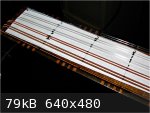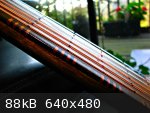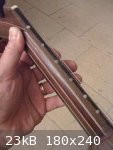
londonoudi - 7-15-2011 at 08:28 PM
This might be a strange one but I want to get a n upgrade oud. The question is, I want to have the fret lines on the instrument.
I know some people use elastic bands but for me this alters the sound. I have seen some people use a coloured pencil. and also have seen some people
actually engrave a shallow line where the tones are.
Some ouds have this as decoration; what is the best way to add lines onto a oud?
Thanks
fingerboard upgrade
spyrosc - 7-15-2011 at 08:55 PM
I've seen some people stick little paper dots on the SIDE of the neck, where the tones should be. That way you can see them from your angle and place
your fingers appropriately and you don't have to destroy or modify the oud.
You can find a thread about that in these forums if you use the SEARCH option.
or check this site:
https://sites.google.com/site/oudguitare/theneck
Good luck
Spyros C.
londonoudi - 7-23-2011 at 03:05 AM
I did a search on this site but I couldn't find anything - what should I be searching for?
I like the idea of tabs on the neck and will try that, but sometimes, I know I shouldnt but I actually look at the face as I am still a little unsure
especially as I go further up the neck for the higher notes.
jdowning - 7-23-2011 at 07:26 AM
Check out "Oud Fingerboard 'Fret' Inlays" on this forum. Fret lines are probably more decorative than practical as you would normally not be looking
at the fingerboard surface when playing. Fret lines are made by grooving and inlaying the fingerboard - not a difficult job for a luthier.
spyrosc suggests placing paper dots on the side of the finger board which is probably the best way to go as they can be removed later without damage
to the instrument. This will enable you to exactly locate the finger positions by trial and error.
If required these can then be replaced by permanent 'dots' glued into shallow holes drilled into the side of the finger board. The 'dots' are made
from dowel or rods made from material of a contrasting colour and trimmed flush after gluing.
littleseb - 7-23-2011 at 10:46 AM
no need for lines, londonoudi! just play as much as you can, you'll be surprised how quickly you can train your ears and hands. pick two or three
basic maqams (eg ajam, nahawand, hijaz), get used to their sounds, and off you go.
seriously, i had similar thoughts when i first started to play, but by the time i got round to actually drawing pencil lines i found i had already
developed a good enough ear to play without, lol.
Check it out
spyrosc - 7-23-2011 at 01:28 PM
Dear Londonoudi,
I'm not sure why you couldn't see the information on that URL.
They have exactly what you want on that site, with exact procedures of where to put the dots. The guy even had a luthier do it, which I don't think
it's necessary, as our friend above is suggesting, it will quickly become second nature to you, so the paper dots are like the training wheels on your
bike and then you take them off.
Good luck
Spyros C.
londonoudi - 7-25-2011 at 10:58 AM
Thanks guys for all your advice. Thanks Spyros for the link, for some reason i totally missed it the first time round.
I think I need to let go and just play - I do more or less know where the notes are, but I like to look and be sure - I dont like to take risks, but I
think I will take you guys' advice and just let go!
I must say i do like the idea of the paper dots though! :-)
Ararat66 - 7-25-2011 at 12:08 PM
Hi Londonoudi
I would suggest the same as Seb. Try to get used to not even looking at the fingerboard and listening really well ... you will be surprised how
quickly you get used to it.
Hope this helps
Leon
paulO - 7-25-2011 at 03:25 PM
Hi Londonoudi,
Yet another vote for, no lines, dots, fret marks, etc.
Regards..Paul
fernandraynaud - 7-25-2011 at 04:42 PM
There are lots of ways to mark "fretlines" but all of them suffer from parallax if you mark the edge of the neck. If you use stickers to mark the
fingerboard, they interfere with the strings/sound.
On the oud, if you are playing Maqamat, no markers based on Equal Tempered scales are "on", because 1) Even the fundamental positions change depending
on the Maqam you are playing in, and 2) You must play by ear.
I'll grant you that at first, markers are not all bad, they can help you figure out where to finger "commas", but please heed my caution notes! The
best way I found at the very beginning was to mark the strings themselves. The technique I used was to wait for the string to be stretched and stable,
then print a template with the free WFRET program. You can get it here:
ftp://mimf.com/pub/wfret.zip
Be careful to do this correctly, with YOUR exact scale length. You only need to print the first 9 "frets". After you've triple-checked your data,
which will look like this for 615 mm scale
Scale Length: 615.0 mm
Fret Number mm from Nut mm from Fret
=========== ============ =============
1 34.5 34.5
2 67.1 32.6
3 97.8 30.8
4 126.9 29.0
5 154.3 27.4
6 180.1 25.9
7 204.5 24.4
8 227.6 23.0
9 249.3 21.7
you print the graphical version, wide enough to slip it under the strings on thick paper. Check it and align it carefully. Then you can put marks on
the strings, in a little ring so it doesn't rub off immediately, or mainly on the side you look down on. On fat strings, there is no rotation, so you
can even make them almost invisible from the front. There are different felt pens you can use.


The strings will not stretch enough to affect the markers if you have given them time to stabilize. As these marks wear off, you will find you don't
need them any longer.
When you change strings, and refresh any coating on your fingerboard (if it's a soft wood that needed a coating), you can wash off any ink that has
rubbed off into the fingerboard.
One SERIOUS word of caution. The proper way to hold the oud is on your right thigh, with the face nearly vertical, meaning you don't look at the
fingerboard. DO NOT hold the oud all wrong to concentrate on the marks, or 1) You will acquire a very bad posture that you will then have to struggle
(a lot) to unlearn and 2) You will not be hearing what is important. Our equal tempered tuning is an ugly compromise. If you play Ajam, which is close
to a C major scale, the third note is not exactly on the equal tempered E. Listen to how much more beautiful it is played correctly, a hair flat,
ESPECIALLY in a chord.
Please accept the truth that you should be playing by ear, and only use the markers at the very beginning. Even if you are playing chords, being a
little off as you learn is not as big a problem as approaching this beautiful instrument all wrong. 
Marcus - 7-25-2011 at 11:14 PM
Hi londonoudi,
one more vote for no lines etc.
To be a bit flat or sharp is even a way to get used to microtones
Cheers
Marcus
billkilpatrick - 8-1-2011 at 05:47 PM
one vote for dots. i put small drops of fingernail polish (white) along the top side of the neck - unnecessary if you play in the halcyon stillness
of your own room but very helpful indeed if you stroll around a dimly lit piazza in the noisy company of hand-drum and tambourine players, searching
for notes.
lines won't help, as you have to crane your neck at an uncomfortable angle to see the fingerboard.




